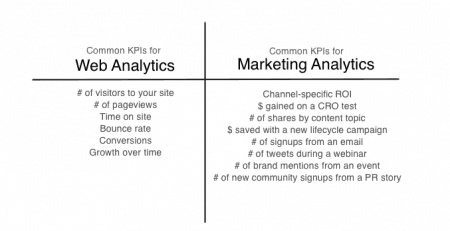In a recent discussion about student recruitment with a senior college marketer, I made the remark that our company’s approach to digital marketing was “analytics-driven“. His pursed lips and annoyed stare told me that what he heard was unhelpful techno-speak and that it was not appreciated. He responded very academically, “That sounds nice, but what does that mean?” So I rolled back the conversations to the basics and happily told him about the central role that analytics plays in our company’s digital marketing practice. The conversation ended well but I’m not holding my breath that he’ll become our next client! “We use an analytics-driven approach.”  “That sounds nice, but what does that mean?” “Analytics” is a term that is thrown around a lot in the business world these days with very mixed interpretation. The rise of the computer in almost every facet of our business and personal lives has brought analytics into broad, general use, and most certainly into the big data world of higher education. This post reviews some basic definitions around analytics in the hope that we might understand each other a bit better during these kinds of conversations in the future.
“That sounds nice, but what does that mean?” “Analytics” is a term that is thrown around a lot in the business world these days with very mixed interpretation. The rise of the computer in almost every facet of our business and personal lives has brought analytics into broad, general use, and most certainly into the big data world of higher education. This post reviews some basic definitions around analytics in the hope that we might understand each other a bit better during these kinds of conversations in the future.
So lets start with the word “analysis”, a term often used synonymously with the word “analytics”.
Definition of Analysis
Analysis is the detailed examination of the elements or structure of something, typically as a basis for discussion or interpretation. Ok, so that make sense. So then what are analytics versus analysis?
Definition of Analytics
Analytics is the science or method of analysis, including the technology and the associated tools for analyzing the data, which produces inferences from this data to drive decisions. Analytics are especially valuable in areas rich with recorded data, like education. Analytics relies on the simultaneous application of statistics, computer programming and operations research to quantify performance. On one hand, analytics uses descriptive and predictive models to gain valuable knowledge from data. On the other hand, analytics uses this insight to recommend action or to guide decision making. So now that we have more clearly defined analytics, lets push on a little farther and look at the three main areas in higher ed where analytics are being applied today.
Definition of Web Analytics
Web analytics is the measurement, collection, analysis and reporting of internet data for purposes of understanding and optimizing web usage. Web analytics examines your institution’s website traffic and visitor behavior. At its simplest level it is page-view centric but with knowledge and expertise, web analytics will reveal deep insight into user behavior and intent. It can reach offline to referring sources and can track a visitors’ path right up to your CRM or call center monitoring system. Website click stream analytics tools include Google Analytics, Yahoo Analytics and for big business, Omniture. Social web applications like Facebook , YouTube and LinkedIn also provide internal analytics capabilities to administrators. For a wide ranging list of leading analytics tools see this link.
Definition of Marketing Analytics
Marketing Analytics is the practice of investigating business data and facts to make optimal and functional marketing decisions. Marketing Analytics is more people centric than site traffic centric. It closely studies the data that reveals the customer’s path from prospect to lead to customer, regardless of channel. It includes the analysis, tracking and optimization of all your marketing activities, (not just website-based), including email, offline-, like television,course calendars, and your customer relationship management system. Web analytics is really a subset of marketing analytics but don’t tell this to a hard core web analyst. They may snap! Marketing analytics tools are as broadly based as marketing itself, including everything from your Excel spreadsheet analyzing monthly financial performance to sales force automation databases like Salesforce to manage your lead to customer relationships. 
Source : SEOMoz
Definition of Learning Analytics
Learning analytics is the measurement, collection, analysis and reporting of data about learners and their contexts, for purposes of understanding and optimizing learning and the environments in which it occurs. Last but not least is the rapidly emerging field of learning analytics. As education reinvents itself and migrates more and more to computer-based and web-based models, learning analytics tools are emerging to collect, analyze and report on the complete learning experience. Learning analytics capabilities are emerging across a wide range of software tools used to organize and track student learning activities and outcomes. Learning management systems are at the heart of learning analytics with tools like Blackboard and Desire2Learn rapidly evolving to incorporate new functionality to address educators analytics needs.
Our Definition of Analytics–Driven Marketing
Analytics-driven marketing is the term we use to describe our approach to higher ed marketing that relies on the use of web analytics and marketing analytics to collect, analyze and report on web traffic, visitor behavior and prospect-to-student behavior to optimize marketing efforts and ROI for our college and university clients. I hope these definitions have shed some light on these terms so that in the future our conversations around analytics can have more clarity and hopefully be more productive.
Now it is your turn to comment. Do your definitions of analytics and interpretations vary from these at all? Does your institution understand and embrace the important role of analytics in managing its marketing efforts? What are your favourite analytics tools? I look forward to hearing your feedback.





